TryHackMe: Splunk - Boss of the SOC v1
This is a write up for the Advanced Persistent Threat and Ransomware tasks of the Splunk room on TryHackMe. Some tasks have been omitted as they do not require an answer.
Advanced Persistent Threat
What IP is scanning our web server?
Navigate to http://10.10.29.30:8000 and then click on Investigating with Splunk Workshop.
We know:
- We have a compromised website: imreallynotbatman.com
- An index called: botsv1
Lets start with a basic search:
index=botsv1 imreallynotbatman.com
This provides ~80,0000 results.
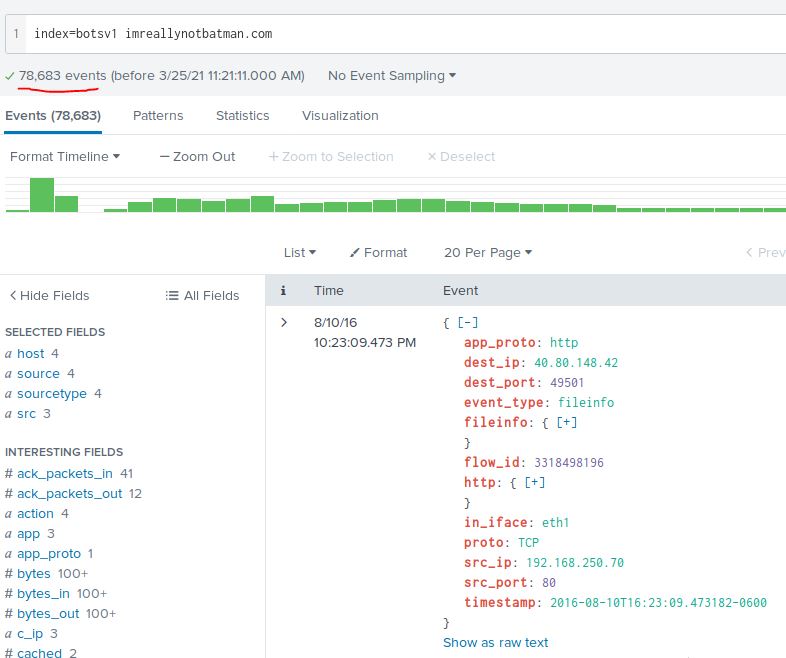
Something that is scanning our webserver is likely to be via HTTP, so lets set sourcetype to stream:http.
index=botsv1 imreallynotbatman.com sourcetype="stream:http"
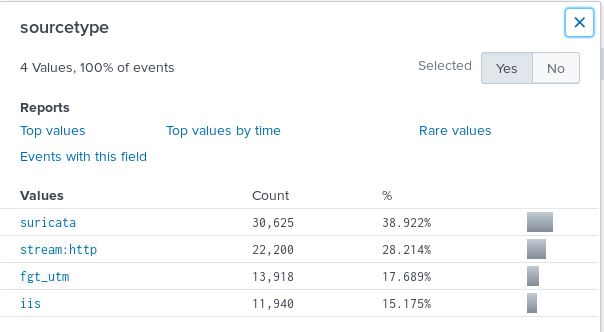
Lets see how many different ip addresses we are dealing with.
index=botsv1 imreallynotbatman.com sourcetype="stream:http" | stats count by src_ip

We can assume that due to the volume of traffic, this source ip is scanning our server.
Answer: 40.80.148.42
What web scanner scanned the server?
Looking at some of the traffic from 40.80.148.42, we can see it is running Acunetix - a vulnerability scanner.

Answer: Acunetix
What is the IP address of our web server?
The requests from 40.80.148.42 are targetting 192.168.250.70
index=botsv1 imreallynotbatman.com sourcetype="stream:http" src_ip="40.80.148.42" | stats count by dest_ip

Answer: 192.168.250.70
What content management system is imreallynotbatman.com using?
Looking at the dest_headers we can see that Joomla is likely to be the CMS in use.
index=botsv1 imreallynotbatman.com sourcetype="stream:http" src_ip="40.80.148.42" dest_ip="192.168.250.70" | top limit=20 dest_headers
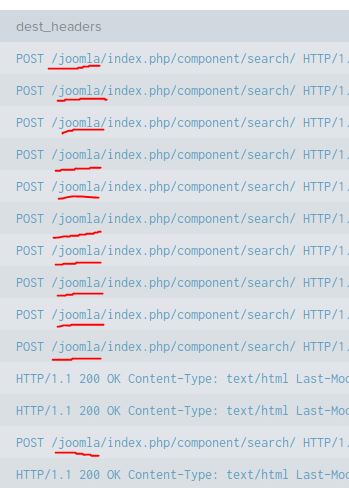
Answer: Joomla
What address is performing the brute-forcing attack against our website?
A brute force attack is against some form of authentication. This will likely require GET/POST requests.
index=botsv1 imreallynotbatman.com sourcetype="stream:http" dest_ip="192.168.250.70" | stats count by http_method

Looking at the http_content for a request shows that the password field is called passwd.

Refining our search further shows how many requests are coming from each ip.
index=botsv1 imreallynotbatman.com sourcetype="stream:http" dest_ip="192.168.250.70" http_method="POST" username passwd | stats count by src_ip

Listing form_data shows a brute force attempt on the admin user.
index=botsv1 imreallynotbatman.com sourcetype="stream:http" src_ip="23.22.63.114" dest_ip="192.168.250.70" http_method="POST" username passwd | top limit=20 form_data

Answer: 23.22.63.114
What was the first password attempted in the attack?
The earliest entry will be at the tail.
index=botsv1 imreallynotbatman.com sourcetype="stream:http" src_ip="23.22.63.114" dest_ip="192.168.250.70" http_method="POST" username passwd | tail 1

Answer: 12345678
One of the passwords in the brute force attack is James Brodsky’s favorite Coldplay song. Which six character song is it?
This is an interesting query as we need to separate the passwords from the form_data.
index=botsv1 imreallynotbatman.com sourcetype="stream:http" src_ip="23.22.63.114" dest_ip="192.168.250.70" http_method="POST" username passwd
| table form_data
| rex field=form_data "passwd=(?<passwd>\w+)"
| table passwd
| regex passwd= \w{6}
There is still 343 possibilities, sorting alphabetically reveals the answer.

Answer: yellow
What was the correct password for admin access to the content management system running imreallynotbatman.com?
index=botsv1 imreallynotbatman.com sourcetype="stream:http" dest_ip="192.168.250.70" http_method="POST" username passwd
| rex field=form_data "passwd=(?<passwd>\w+)"
| stats count by passwd
| where count>1

Answer: batman
What was the average password length used in the password brute forcing attempt rounded to closest whole integer?
index=botsv1 imreallynotbatman.com sourcetype="stream:http" dest_ip="192.168.250.70" http_method="POST" username passwd
| rex field=form_data "passwd=(?<passwd>\w+)"
| eval length=len(passwd)
| stats avg(length)

Answer: 6
How many seconds elapsed between the time the brute force password scan identified the correct password and the compromised login rounded to 2 decimal places?
index=botsv1 imreallynotbatman.com sourcetype="stream:http" dest_ip="192.168.250.70" http_method="POST" username passwd | rex field=form_data "passwd=(?<passwd>\w+)" | search passwd=batman
| transaction passwd
| eval dur=round(duration, 2)
| table dur
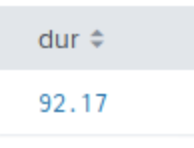
Answer: 92.17
How many unique passwords were attempted in the brute force attempt?
index=botsv1 imreallynotbatman.com sourcetype="stream:http" dest_ip="192.168.250.70" http_method="POST" username passwd
| rex field=form_data "passwd=(?<passwd>\w+)"
| stats count by passwd

Answer: 412
What is the name of the executable uploaded by P01s0n1vy?
index=botsv1 imreallynotbatman.com sourcetype="stream:http" dest_ip="192.168.250.70" form-data

Answer: 3791.exe
What is the MD5 hash of the executable uploaded?
index=botsv1 3791.exe md5 sourcetype="XmlWinEventLog:Microsoft-Windows-Sysmon/Operational" CommandLine="3791.exe"
| rex field="_raw" "MD5=(?<hash>\w+)"
| table hash
| stats count by hash

Answer: AAE3F5A29935E6ABCC2C2754D12A9AF0
What is the name of the file that defaced the imreallynotbatman.com website?
index=botsv1 sourcetype="suricata" src_ip="192.168.250.70" dest_ip="23.22.63.114"
| stats count by http.http_method, http.hostname, http.url
| sort -count
Answer: poisonivy-is-coming-for-you-batman.jpeg
This attack used dynamic DNS to resolve to the malicious IP. What fully qualified domain name (FQDN) is associated with this attack?
index=botsv1 sourcetype=fgt_utm "poisonivy-is-coming-for-you-batman.jpeg"
| rex field="_raw" "hostname=(?<hostname>\w+)"
| table hostname

Answer: prankglassinebracket.jumpingcrab.com
What IP address has P01s0n1vy tied to domains that are pre-staged to attack Wayne Enterprises?
index=botsv1 sourcetype=fgt_utm "poisonivy-is-coming-for-you-batman.jpeg"
| table dstip

Answer: 23.22.63.114
Based on the data gathered from this attack and common open source intelligence sources for domain names, what is the email address that is most likely associated with P01s0n1vy APT group?
Doing a google search for 23.22.63.114 provdes the following page: https://www.threatcrowd.org/ip.php?ip=23.22.63.114.
On this page a diagram is provided which reveals a potential email address.

Answer: lilian.rose@po1s0n1vy.com
GCPD reported that common TTPs (Tactics, Techniques, Procedures) for the P01s0n1vy APT group if initial compromise fails is to send a spear phishing email with custom malware attached to their intended target. This malware is usually connected to P01s0n1vy’s initial attack infrastructure. Using research techniques, provide the SHA256 hash of this malware.
Searching for 23.22.63.114 malware hash provides a link to https://www.threatminer.org/host.php?q=23.22.63.114#gsc.tab=0&gsc.q=23.22.63.114&gsc.page=1.
This reveals a hash for a number of trojans.

Following the link on the MD5 provides a SHA256 hash related to this malware - https://www.threatminer.org/sample.php?q=c99131e0169171935c5ac32615ed6261#gsc.tab=0&gsc.q=c99131e0169171935c5ac32615ed6261&gsc.page=1

Answer: 9709473ab351387aab9e816eff3910b9f28a7a70202e250ed46dba8f820f34a8
What special hex code is associated with the customized malware discussed in the previous question?
Following the VirusTotal link on the previous page reveals the HEX code - https://www.virustotal.com/gui/file/9709473ab351387aab9e816eff3910b9f28a7a70202e250ed46dba8f820f34a8/community

Answer: 53 74 65 76 65 20 42 72 61 6e 74 27 73 20 42 65 61 72 64 20 69 73 20 61 20 70 6f 77 65 72 66 75 6c 20 74 68 69 6e 67 2e 20 46 69 6e 64 20 74 68 69 73 20 6d 65 73 73 61 67 65 20 61 6e 64 20 61 73 6b 20 68 69 6d 20 74 6f 20 62 75 79 20 79 6f 75 20 61 20 62 65 65 72 21 21 21
What does this hex code decode to?
Putting the HEX code into an online converter (https://cryptii.com/pipes/hex-decoder) reveals the following message.

Answer: Steve Brant’s Beard is a powerful thing. Find this message and ask him to buy you a beer!!!
Ransomware
What was the most likely IP address of we8105desk on 24AUG2016?
index=botsv1 host=we8105desk| top limit=20 src_ip

Answer: 192.168.250.100
What is the name of the USB key inserted by Bob Smith?
index=botsv1 host=we8105desk sourcetype=WinRegistry friendlyname
| top limit=1 data

Answer: MIRANDA_PRI
After the USB insertion, a file execution occurs that is the initial Cerber infection. This file execution creates two additional processes. What is the name of the file?
index=botsv1 host=we8105desk sourcetype="XmlWinEventLog:Microsoft-Windows-Sysmon/Operational" "d:\\"
| reverse
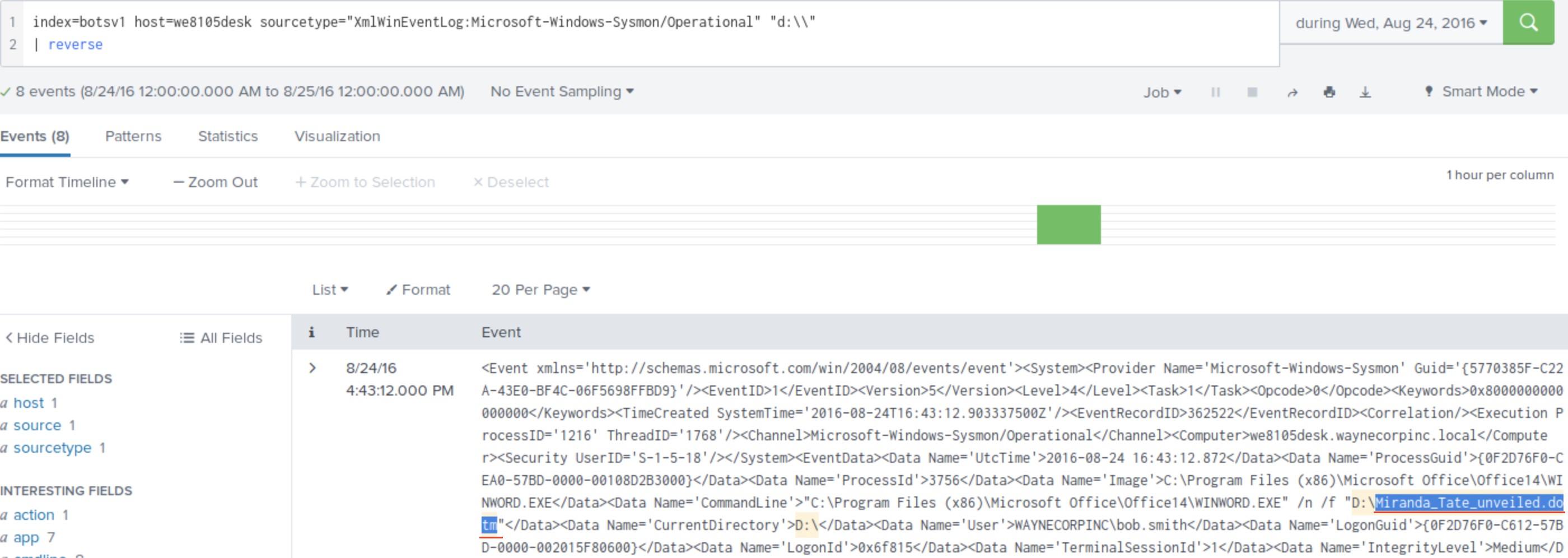
Answer: miranda_tate_unveiled.dotm
During the initial Cerber infection a VB script is run. The entire script from this execution, pre-pended by the name of the launching .exe, can be found in a field in Splunk. What is the length in characters of this field?
index=botsv1 sourcetype="XmlWinEventLog:Microsoft-Windows-Sysmon/Operational" *.exe CommandLine=* EventCode=1
| eval length=len(CommandLine)
| table CommandLine length
| sort - 1 length

Answer: 4490
Bob Smith’s workstation (we8105desk) was connected to a file server during the ransomware outbreak. What is the IP address of the file server?
index=botsv1 host="we8105desk" sourcetype="XmlWinEventLog:Microsoft-Windows-Sysmon/Operational" src="we8105desk.waynecorpinc.local"
| stats count by dest_ip

Answer: 192.168.250.20
What was the first suspicious domain visited by we8105desk on 24AUG2016?
index=botsv1 src="192.168.250.100" sourcetype="stream:dns" record_type=A NOT (query{}=*.microsoft.com OR query{}=*.bing.com OR query{}=wpad* OR query{}=isatap OR query{}=*.waynecorpinc.local OR query{}=*.windows.com OR query{}=*.msftncsi.com)
| table _time query{} src dest
| reverse

Answer: solidaritedeproximite.org
The malware downloads a file that contains the Cerber ransomware cryptor code. What is the name of that file?
index=botsv1 src="192.168.250.100" sourcetype="suricata" url=*
| stats count values(url) by dest

The first result is mhtr.jpg, doing a google search of this file reveals it is related to a ransomware attack.
Answer: mhtr.jpg
What is the parent process ID of 121214.tmp?
index=botsv1 sourcetype="XmlWinEventLog:Microsoft-Windows-Sysmon/Operational" 121214.tmp
| table _time CommandLine ProcessId ParentProcessId ParentCommandLine
| reverse

Answer: 3968
Amongst the Suricata signatures that detected the Cerber malware, which signature ID alerted the fewest number of times?
index=botsv1 sourcetype=suricata alert.signature=*cerber*
| stats count by alert.signature_id

Answer: 2816763
The Cerber ransomware encrypts files located in Bob Smith’s Windows profile. How many .txt files does it encrypt?
index=botsv1 sourcetype="XmlWinEventLog:Microsoft-Windows-Sysmon/Operational" host=we8105desk *.txt EventCode=2 TargetFilename="C:\\Users\\bob.smith.WAYNECORPINC\\*.txt"
| stats dc(TargetFilename)

Answer: 406
How many distinct PDFs did the ransomware encrypt on the remote file server?
index=botsv1 sourcetype="*win*" pdf dest="we9041srv.waynecorpinc.local" Source_Address="192.168.250.100"
| stats dc(Relative_Target_Name)

Answer: 257
What fully qualified domain name (FQDN) does the Cerber ransomware attempt to direct the user to at the end of its encryption phase?
index=botsv1 sourcetype="stream:DNS" src=192.168.250.100 record_type=A NOT (query{}=*.microsoft.com OR query{}=wpad OR query{}=isatap OR query{}=*.waynecorpinc.local OR query{}=*.bing.com OR query{}=*.windows.com OR query{}=*.msftncsi.com OR query{}=*.live.com)
| table _time query{} src dest

Answer: cerberhhyed5frqa.xmfir0.win
Recap
In this task we learnt how to:
- Conduct search queries to find information in Splunk
- Find identifiers of APT activity
- Find identifiers of Ransomware activity
- Conduct OSINT to find malware information